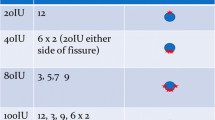Abstract
Rectovaginal fistula is abnormal connections between the vagina and rectum. Via this connection, the passages of flatus or stool from rectum to vagina occur. Patient history and physical examination are usually enough to make diagnosis of fistula. Although there are so many defined surgical options including sphincteroplasty, advanced flap, muscle interposition, fibrin glue, plugs, and closure of fistulas remain a challenging condition with the high rate failure of surgical repair In this study, we aim to report the results of a new treatment approach with the injection of botulinum toxin into lateral internal sphincter on the management of rectovaginal fistula in conjunction with the surgical repair. Between 2013 and 2019, 8 patients with recurrent rectovaginal fistula underwent 10 surgical repairs in conjunction with 100 units botulinum toxin injection. Results of these patients were analyzed. We have treated 8 patients with recurrent rectovaginal fistula. The etiology of fistula in our patients included obstetrical trauna (3 patients), radiotherapy and rectal surgery (2 patients), vaginal reconstruction (2 patients) and Crohn’s disease (1 patient). The median number of their previous operations was 1.5 (range, 1–3). The sizes of fistulas range from 0.5 × 1 to 2 × 3 cm. In our surgical intervention, at the end, all of them were closed (100%) successfully. Botulinum toxin injection into lateral internal sphincter can be used successfully in combination with surgical intervention for the treatment of the rectovaginal fistulas.

Similar content being viewed by others
Abbreviations
- BMI:
-
body mass index
- RVF:
-
rectovaginal fistula
- TVR:
-
transvaginal repair
- ERAF:
-
endorectal advancement flap
- BTX:
-
botulinum toxin
- RT:
-
radiation therapy
References
Debeche-Adams TH, Bohl JL (2010) Rectovaginal fistulas. Clin Colon Rectal Surg. 23(2):99–103. https://doi.org/10.1055/s-0030-1254296
Fu J, Liang Z, Zhu Y, Cui L, Chen W (2019) Surgical repair of rectovaginal fistulas: predictors of fistula closure. Int Urogynecol J. 30(10):1659–1665. https://doi.org/10.1007/s00192-019-04082-w
Ryoo SB, Oh HK, Ha HK, Han EC, Kwon YH, Song I, Moon SH, Choe EK, Park KJ (2019) Outcomes of surgical treatments for rectovaginal fistula and prognostic factors for successful closure: a single-center tertiary hospital experiences. Ann Surg Treat Res. 97(3):149–156. https://doi.org/10.4174/astr.2019.97.3.149
Das B, Snyder M (2016) Rectovaginal fistulae. Clin Colon Rectal Surg. 29(1):50–56. https://doi.org/10.1055/s-0035-1570393
Goldaber KG, Wendel PJ, McIntire DD, Wendel GD Jr (1993) Postpartum perineal morbidity after fourth-degree perineal repair. Am J Obstet Gynecol 168(2):489–493
Pinto RA, Peterson TV, Shawki S, Davila GW, Wexner SD (2010) Are there predictors of outcome following rectovaginal fistula repair? Dis Colon Rectum. 53(9):1240–1247. https://doi.org/10.1007/DCR.0b013e3181e536cb
Takano S, Boutros M, Wexner SD (2014) Gracilis transposition for complex perineal fistulas: ectovaginal fistula and rectourethral fistula. Dis Colon Rectum. 57(4):538. https://doi.org/10.1097/DCR.0000000000000093
Seow-Choen F, Seow-En I (2013) Martius flap for ano-vaginal fistula: a photographic step by step guide. Tech Coloproctol. 17(4):467–468. https://doi.org/10.1007/s10151-012-0855-0
Gottgens KW, Smeets RR, Stassen LP, Beets G, Breukink SO (2014) The disappointing quality of published studies on operative techniques for rectovaginal fistulas: a blueprint for a prospective multi-institutional study. Dis Colon Rectum 57(7):888–898. https://doi.org/10.1097/DCR.0000000000000147
Tozer PJ, Balmforth D, Kayani B, Rahbour G, Hart AL, Phillips RK (2013) Surgical management of rectovaginal fistula in a tertiary referral centre: many techniques are needed. Colorectal Dis. 15(7):871–877. https://doi.org/10.1111/codi.12114
Piekarski JH, Jereczek-Fossa BA, Nejc D, Pluta P, Szymczak W, Sek P et al (2008) Does fecal diversion offer any chance for spontaneous closure of the radiation-induced rectovaginal fistula? Int J Gynecol Cancer. 18(1):66–70. https://doi.org/10.1111/j.1525-1438.2007.00954.x
Hackert T, Klaiber U, Hinz U, Kehayova T, Probst P, Knebel P et al (2017) Sphincter of Oddi botulinum toxin injection to prevent pancreatic fistula after distal pancreatectomy. Surgery 161:1444–1450 [PubMed
Pilkington SA, Bhome R, Welch RE, Ku F, Warden C, Harris S, Hicks J, Richardson C, Dudding TC, Knight JS, King AT, Mirnezami AH, Beck NE, Nichols PH, Nugent KP (2018) Bilateral versus unilateral botulinum toxin injections for chronic anal fissure: a randomised trial. Tech Coloproctol. 22(7):545–551. https://doi.org/10.1007/s10151-018-1821-2
Pricolo VE, Shellito PC (1994) Surgery for radiation injury to the large intestine. Variables influencing outcome. Dis Colon Rectum 37:675–684
Brown HW, Wang L, Bunker CH, Lowder JL (2012) Lower reproductive tract fistula repairs in inpatient US women, 1979-2006. Int Urogynecol J 23:403–410
Maeda K, Koide Y, Hanai T, Sato H, Masumori K, Matsuoka H, Katsuno H (2015) The longterm outcome of transvaginal anterior levatorplasty for intractable rectovaginal fistula. Colorectal Dis 17:1002–1006
Saclarides TJ (2002) Rectovaginal fistula. Surg Clin North Am 82:1261–1272
Corte H, Maggiori L, Treton X, Lefevre JH, Ferron M, Panis Y (2015) Rectovaginal fistula: what is the optimal strategy?: an analysis of 79 patients undergoing 286 procedures. Ann Surg 262:855–860
Sjoveian S, Vangen S, Mukwege D, Onsrud M (2011) Surgical outcome of obstetric fistula: a retrospective analysis of 595 patients. Acta Obstet Gynecol Scand 90:753–760
Kniery KR, Johnson EK, Steele SR (2015) Martius flap for repair of recurrent rectovaginal fistulas. Dis Colon Rectum 58:1210
Author information
Authors and Affiliations
Corresponding author
Ethics declarations
Conflict of Interest
The authors declare no competing interests.
Additional information
Publisher’s Note
Springer Nature remains neutral with regard to jurisdictional claims in published maps and institutional affiliations.
Rights and permissions
About this article
Cite this article
Yetisir, F., Güzel, K. Botulinum Toxin Injection for the Treatment of the Recurrent Rectovaginal Fistulas in Combination with Surgical Repair. Indian J Surg 84, 190–194 (2022). https://doi.org/10.1007/s12262-021-02823-0
Received:
Accepted:
Published:
Issue Date:
DOI: https://doi.org/10.1007/s12262-021-02823-0



